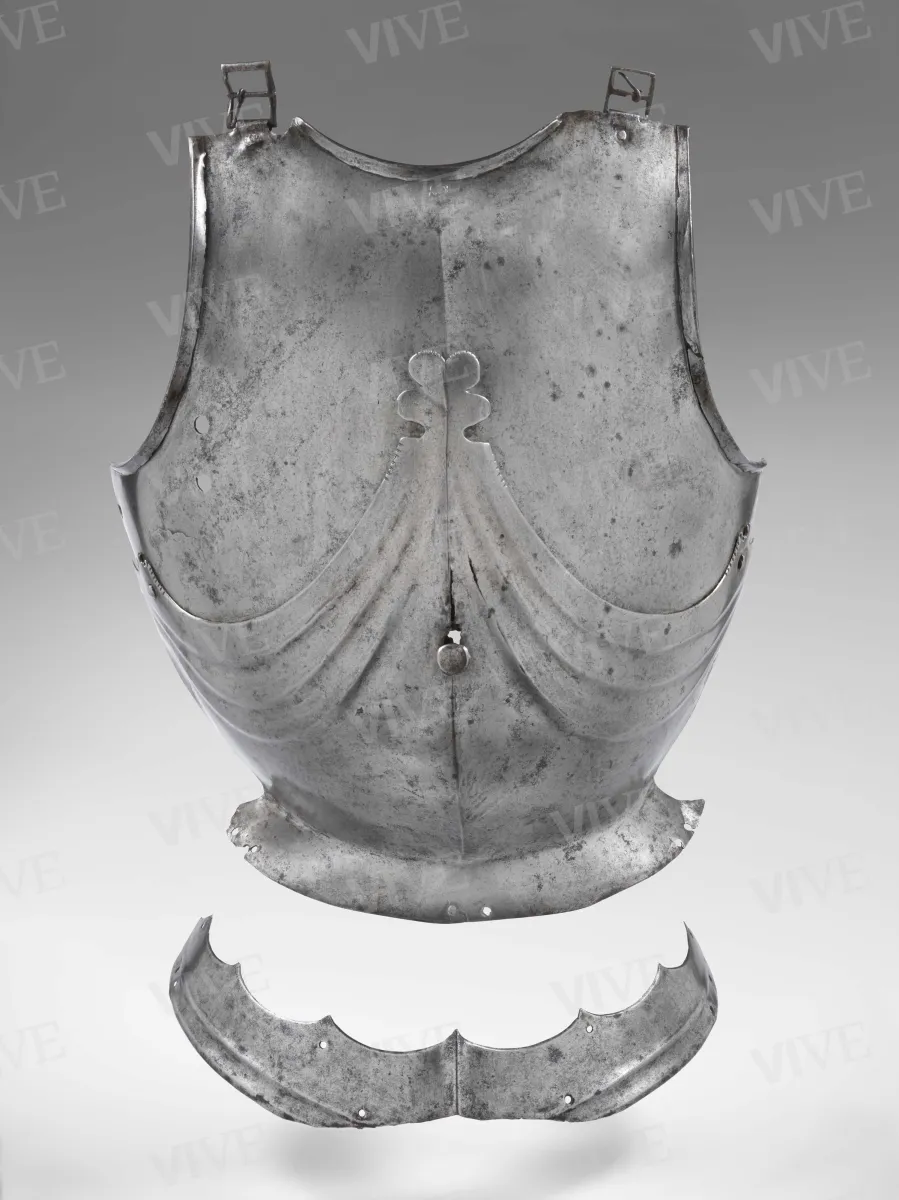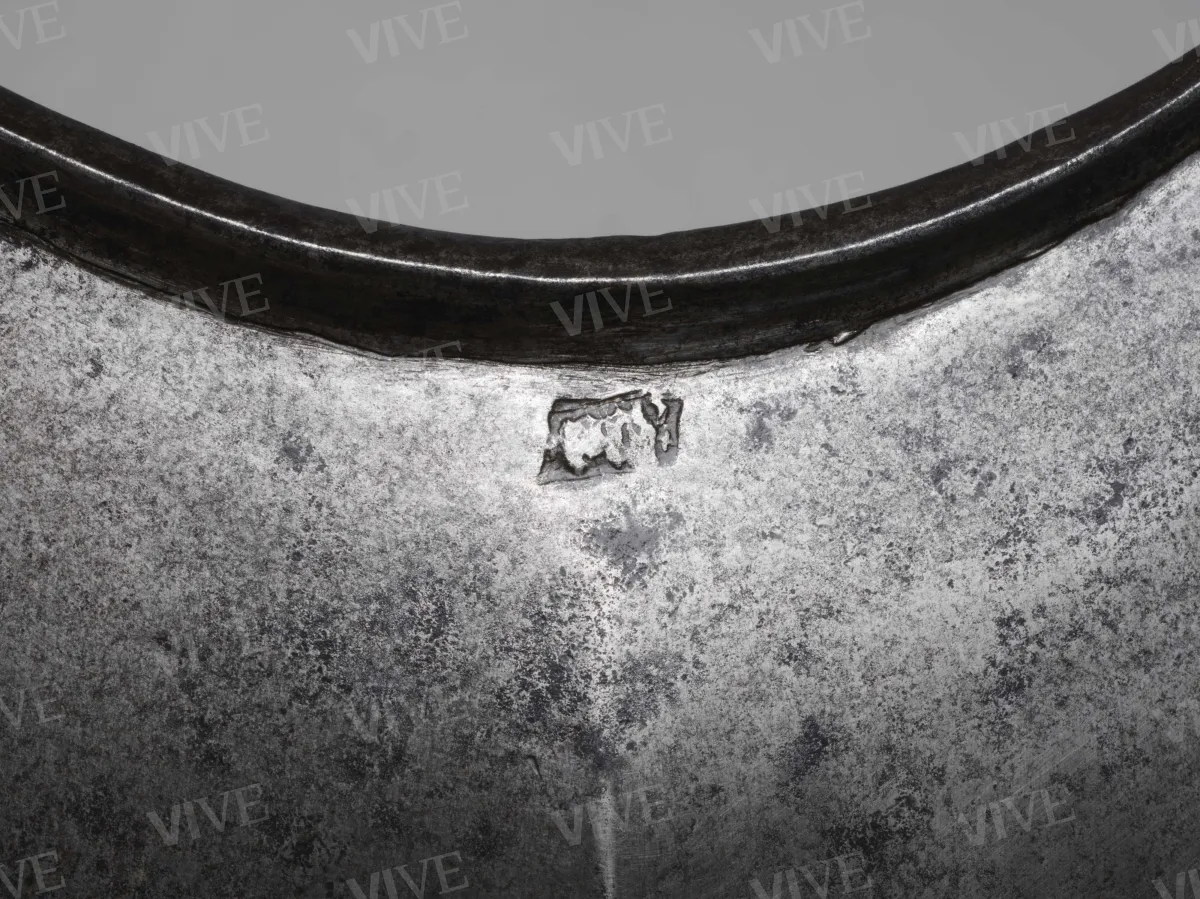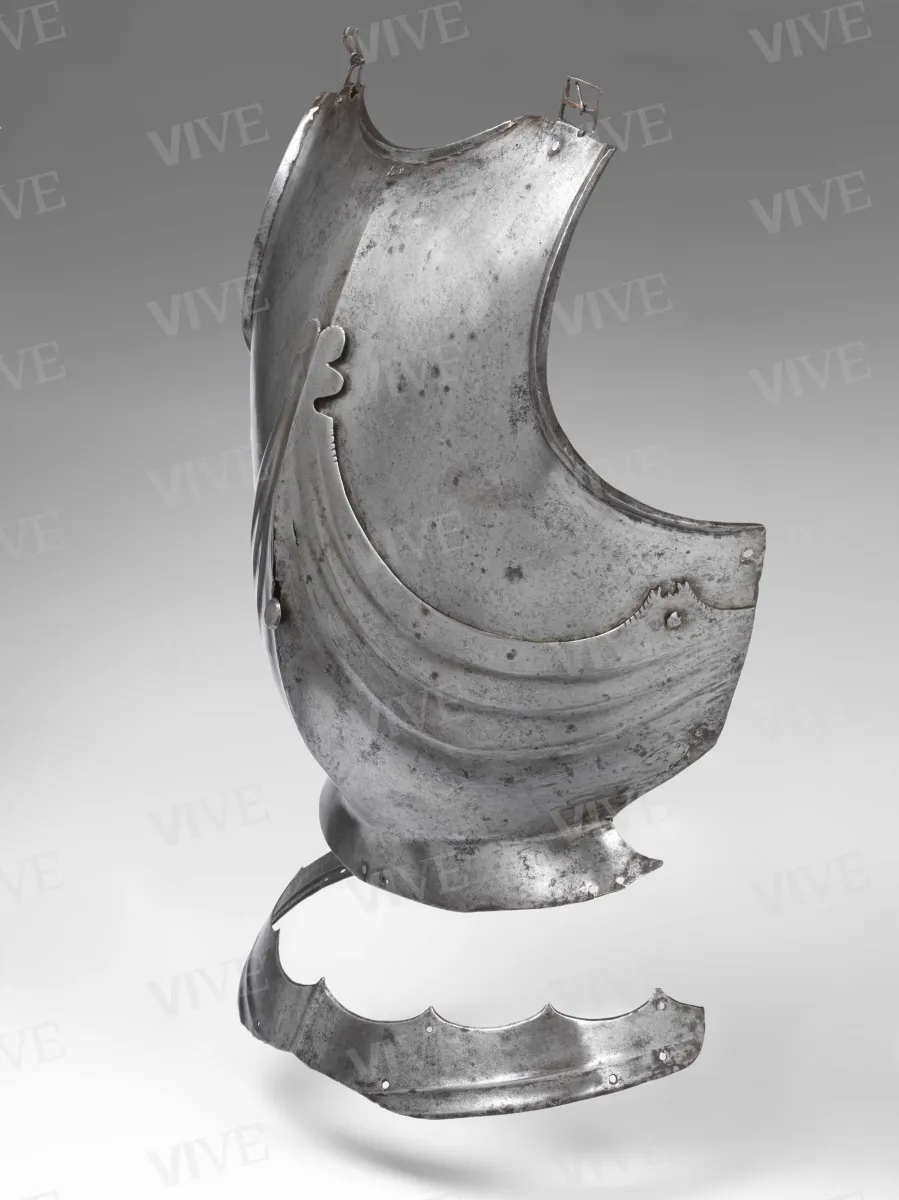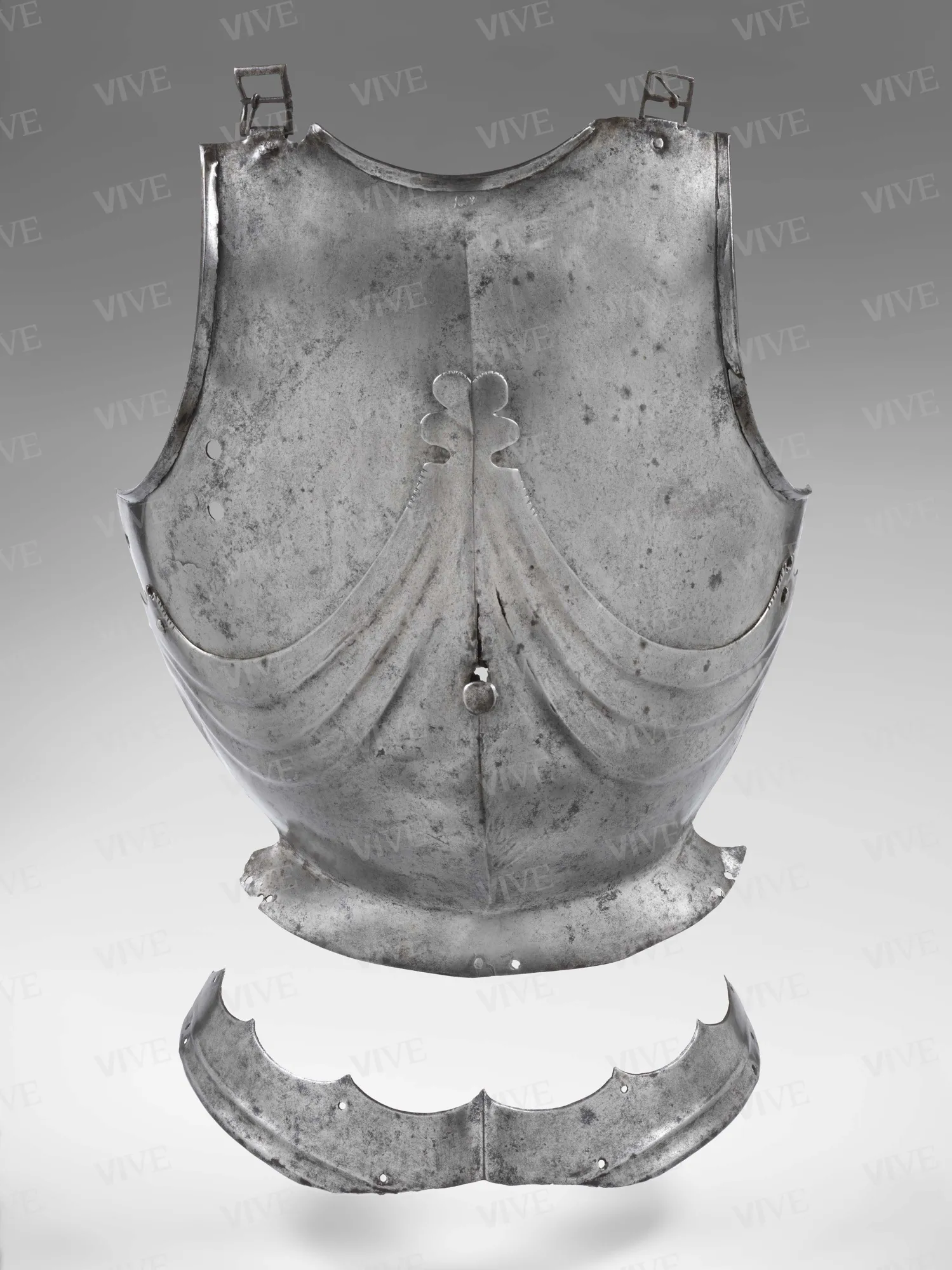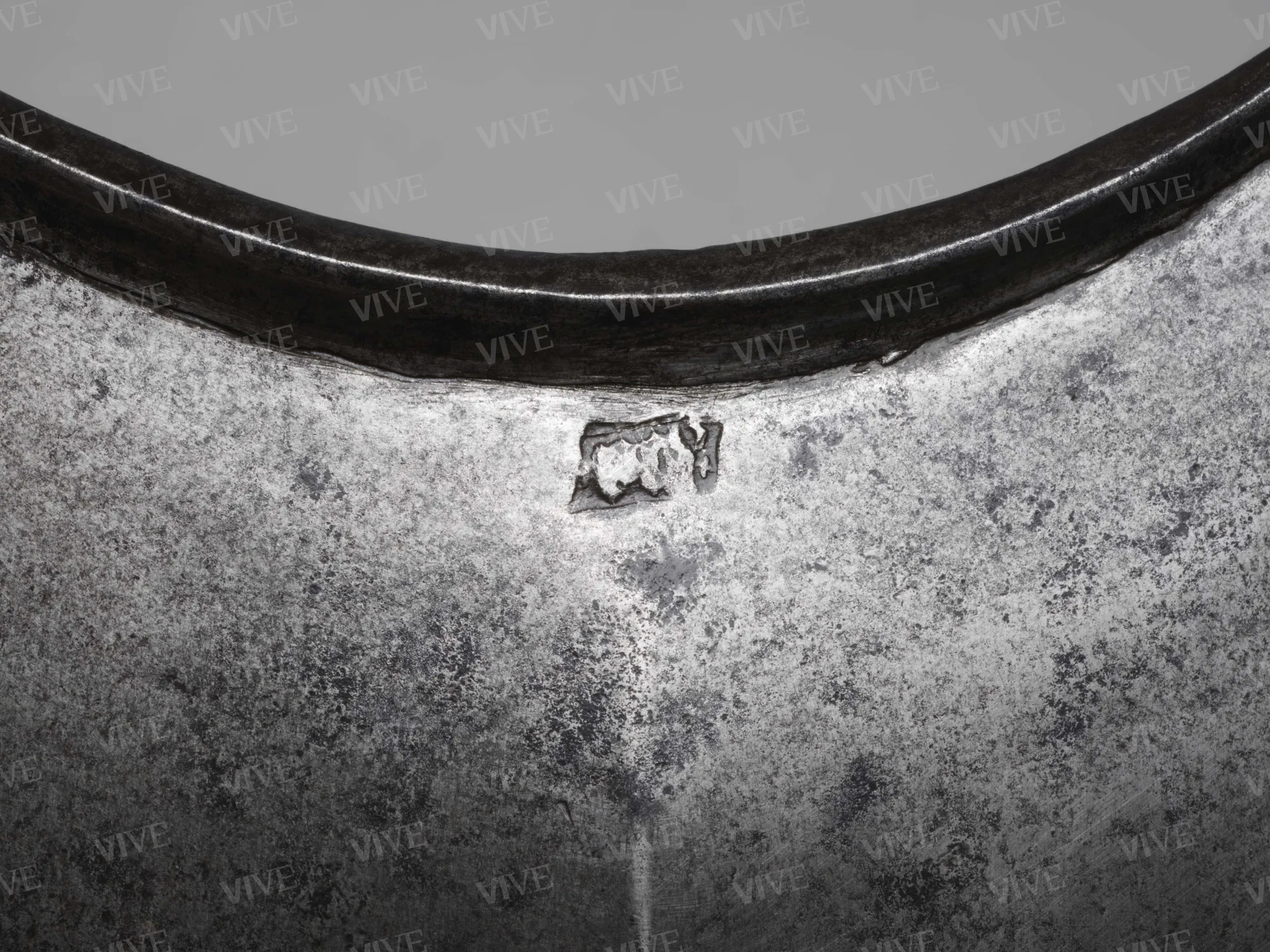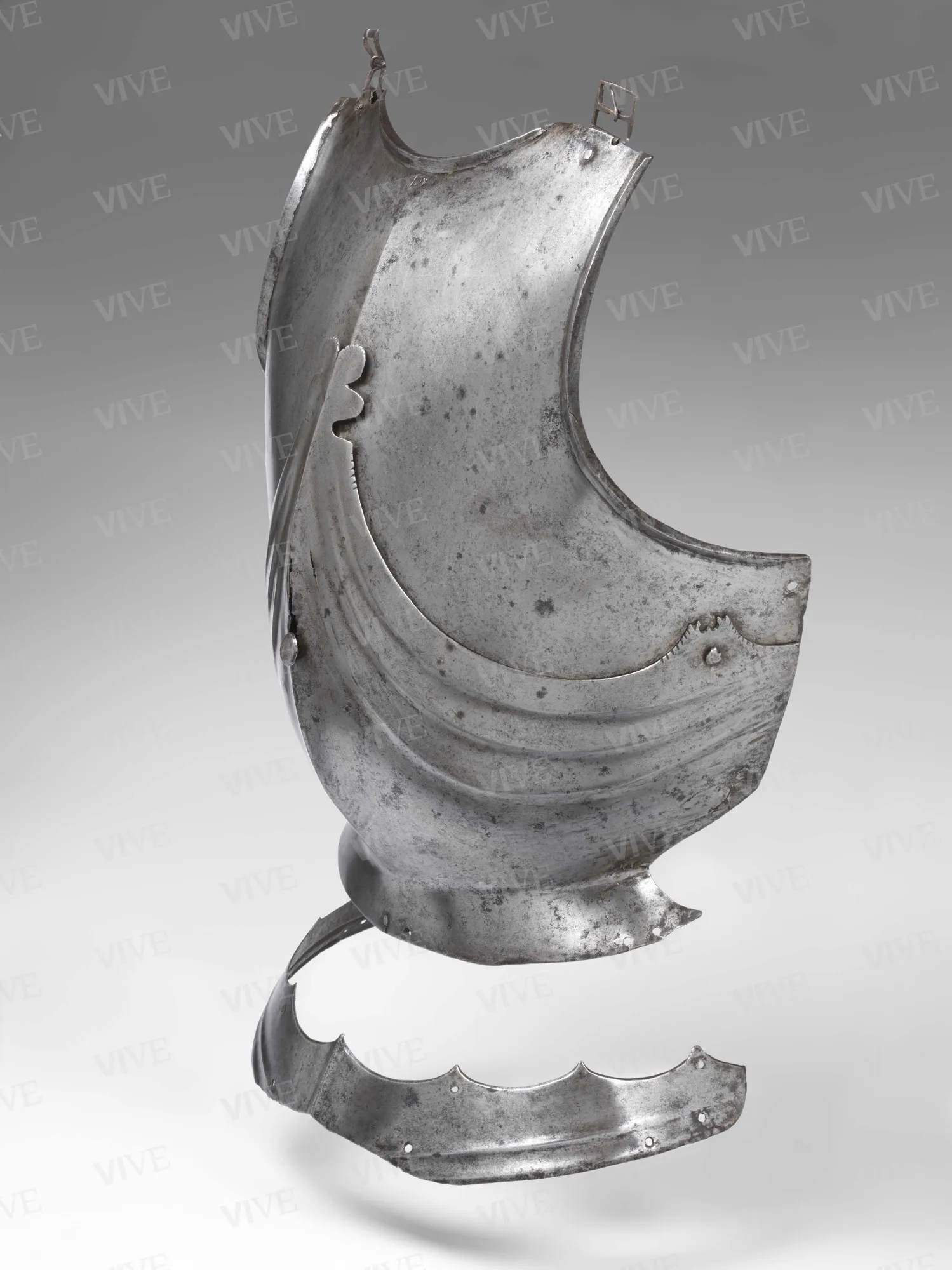Chest armor
Hans Vetterlein 1470–1480
The chest armor is composed of a breastplate, paunch plate, and separate backplate. This metal armor became prevalent towards the end of the fourteenth century and was highly resistant to weapon blows in battle. Both simple, smooth versions and richly decorated versions have been documented. Breastplates of this type were produced in workshops in northern Italy and Austria. This specific breastplate is attributed to Hans Vetterlein's workshop, as evidenced by his workshop mark.
The chest armor is composed of a breastplate, paunch plate, and separate backplate. This metal armor became prevalent towards the end of the fourteenth century and was highly resistant to weapon blows in battle. Both simple, smooth versions and richly decorated versions have been documented. Breastplates of this type were produced in workshops in northern Italy and Austria. This specific breastplate is attributed to Hans Vetterlein's workshop, as evidenced by his workshop mark.
Details of work
Catalog entry
The breastplate consists of three parts: the main breastplate, which is smooth with boxed edges and has holes on the right for attachment; the lower section, known as the paunch, which is pointed with lateral edges alongside two deep shells ending in a four-lobed tip (one of which has carved teeth, also present on the edge where it is riveted to the chestplate); and a single blade flap, with seven points on its upper side (di Carpegna 1969, p. 21, n. 104). The item is well-preserved with visible signs of impacts on the breastplate.
Plates of this kind, made entirely of metal, became widespread in Europe towards the end of the fourteenth century, replacing the protection provided by chain mail (the hauberk) covered with hardened leather or small metal plates
The new armors demonstrated increased resistance to bladed weapons, despite their heavier and more rigid construction. These armors could either be completely smooth or adorned with intricate engravings or embossed reliefs depicting both sacred and profane images. Additionally, a lining was affixed beneath the breastplate using rivets to enhance the fit (Gelli 1900, pp. 242 and 248; Oakeshott 2012, pp. 75–95; La Rocca 2017, pp. 51–55).
This artifact, despite being heavily worn, bears a weapons maker’s mark identified as the initials of Hans Vetterlein, an armor maker active in Innsbruck, Austria, between 1452 and 1483. He marked his creations with the letters “VET” (for example at the Kunsthistorisches Museum in Vienna, inv. A3b, on a pair of smooth gauntlets). Other known works by this weapons maker include an iron hat, another breastplate, and a pole guard, which are part of the collections at Palazzo Venezia (di Carpegna 1969, p. 26, n. 135, for inv. 12012, see relevant file).
A plate similar to this one and attributed to German workshops can be found in the Metropolitan Museum in New York (inv. 48.149.32; Nickel, Pyhrr, Tarassuk 1982, pp. 29–30, n. 5). Another piece resides in the Philadelphia Museum of Art (von Kienbusch Collection, inv. 1977–167–135), which retains traces of polychrome decoration dating back to the early sixteenth century.
This plate was acquired by Prince Ladislao Odescalchi (1846–1922) from the English antiquarian Samuel James Whawell. Whawell, who also acted as an agent for Otto von Kienbusch, maintained a close correspondence with Ladislao, frequently sharing updates about the antique arms market as well as their personal friendship. The chest is prominently featured in a photograph published by Stuart W. Pyhrr (1994, p. 16), depicting the interior of Whawell’s residence in Eastbourne, UK, in 1905. In the photograph, a cuirass (inv. 12063, see related file) and several swords are also visible (Barberini 2007, pp. 109–110).
Giulia Zaccariotto
Entry published on 27 March 2025
State of conservation
Good.
Coats of arms, emblems, and marks
Positioned centrally beneath the collar, there is a rectangular label bearing certain letters.
Provenance
Eastbourne, James Whawell Collection;
Collezione Ladislao Odescalchi (Odescalchi, no. 776);
acquired by the Italian State, 1959;
Rome, Museo Nazionale di Palazzo Venezia, 1969.
Exhibition history
Rome, Museo Nazionale di Palazzo Venezia, Antiche armi dal sec. IX al XVIII. Già Collezione Odescalchi, May–July 1969;
Rome, Castel Sant’Angelo; Rome, Museo Nazionale di Palazzo Venezia, Armi e potere nell’Europa del Rinascimento, July 26–November 11, 2018.
References
Gelli Jacopo, Guida del raccoglitore e dell’amatore di armi antiche, Milano 1900;
di Carpegna Nolfo (a cura di), Antiche armi dal sec. IX al XVIII. Già Collezione Odescalchi, catalogo della mostra (Roma, Museo Nazionale di Palazzo Venezia, maggio-luglio 1969) con schede a firma del curatore, Roma 1969, p. 21, n. 104;
di Carpegna Nolfo, Le armi Odescalchi, Roma 1976;
Nickel Helmut, Pyhrr Stuart W., Tarassuk Leonid, The Art of Chivalry. European Arms and Armor from the Metropolitan Museum of Art, New York 1982;
Pyhrr Stuart W., S.J. Whawell and the Art Market, in The Eleventh Park Lane Arms Fair, London 1994, pp. 14-23;
Barberini Maria Giulia, La collezione Odescalchi di armi antiche: storia della raccolta del principe Ladislao, in «Bollettino d’arte», s. VI, XCI, 2006 (2007), 137/138, pp. 101-114;
Fossà Bianca, Studio conservativo delle armi e armature Odescalchi. Nuove metodologie per la schedatura di una collezione, in «Bollettino d’arte», s. VI, XCI, 2006 (2007), 137/138, pp. 115-142;
Oakeshott Ewart, European Weapons and Armour. From the Renaissance to the Industrial Revolution, Woodbridge 2012;
La Rocca Donald J., How to Read European Armor, New York 2017;
Scalini Mario (a cura di), Armi e potere nell’Europa del Rinascimento, catalogo della mostra (Roma, Museo Nazionale di Castel Sant’Angelo; Roma, Museo Nazionale di Palazzo Venezia, 26 luglio-11 novembre 2018), con schede a firma del curatore, Cinisello Balsamo 2018, p. 230, n. VIII.5.

